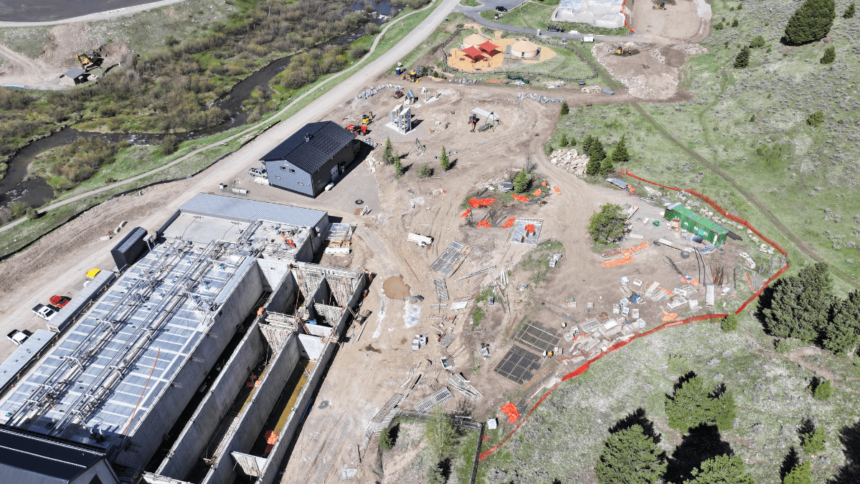BIG SKY — As the noon sun beat down, construction equipment humming across the land of the Big Sky Water and Sewer District put the final touches on six years of work.
The new Water Resource Recovery Facility sits just east of the Town Center and a few hundred feet from the Gallatin River. The view from its deck showed a changing Big Sky. In the shadow of Lone Peak, workers built rows of condos that will send wastewater to be treated at the plant. In the opposite direction were stacks of concrete stored for the sewer district’s expansion.
Across the road, the Gallatin River weaves through wetlands. Memories of bright-green algal blooms that have formed downstream the last several summers — and a formal Environmental Protection Agency impairment designation of 40 river miles — coincide with the sewer district’s overhaul that cost more than $50 million.
The upgrade doubled the sewer district’s wastewater capacity and improved the treatment and removal of nutrients. That’s key given the steady growth of new sewer hook-ups in Big Sky and a push to get housing units off individual septic systems. Montana scientists have linked nitrogen and phosphorus pollution from septic tanks, overirrigation with wastewater and fertilizer runoff to the Gallatin River’s algae growth, which deprives fish of oxygen and harms aquatic insects.
The new plant went fully online in May, and by mid-June, workers were cleaning up construction materials, the district’s general manager Ron Edwards said on a recent tour.
“It’s like going from driving a Buick to a Ferrari,” Edwards said of the project, funded largely by a 1 percent increase in the local resort tax.
Credit: Isabel Hicks / MTFP
Unlike Bozeman and most U.S. cities, Big Sky does not have a permit to directly discharge treated wastewater into the Gallatin River. Instead the sewer district stores wastewater in holding ponds in the winter and uses it to irrigate the Big Sky, Yellowstone Club and Spanish Peaks golf courses in the summer.
The wastewater treated here has more than doubled over the last 30 years. Peak flows reached 80 million gallons a year in 1993. By 2022, they had grown to 176 million gallons. The number of permits managed by the district has grown by about 4.4% each year. Back in 1990, the district held 1,500 permits. Today it’s close to 7,000. With the facility expansion, that could grow to 10,000, Edwards said.
To keep pace with the growth, the district plans to expand its options for reusing the wastewater. Now, the treated effluent will meet the Montana Department of Environmental Quality (DEQ)’s Class A-1 standards. Meeting those standards “unshackles the handcuffs” on reuse allowed by DEQ, said the district’s wastewater superintendent, Adam Rutz.
Last winter, the Yellowstone Club started pumping some 20 million gallons of treated wastewater through a seven-mile uphill pipeline to make snow on its private ski resort. Spanish Peaks Mountain Club is working to obtain its own snowmaking permit too, and Edwards said Big Sky Resort is exploring it.
“It costs an extreme amount of money to operate all these systems,” Edwards said. “The easiest option for us would be to build a pipeline to the Gallatin River downhill from us. From an operational standpoint, that would be a much cheaper way to manage our treated water. But we don’t do that because of the commitment the community has to reuse.”
AE2S, an engineering consultant firm based in Bozeman, started designing the project in 2018, and the contractor RSCI started construction in June 2021. The upgrade bumps the average daily capacity from around 650,000 to 910,000 gallons, with a peak capacity of 1.4 million gallons, and reduces nitrogen concentrations by 75% and phosphorus by 95% in the treated wastewater.
Rutz said the upgrade from the previous system installed in 2004 advances the treatment technology by some 20 years.

Credit: Isabel Hicks / MTFP
To grow bacteria for the new plant, the district trucked 80,000 gallons of seed sludge from Bozeman through Gallatin Canyon. Healthy biology from an existing plant was key to growing good bacteria, which break down nutrients in the wastewater, said Zach Frieling, a process engineer for AE2S who helped design the plant.
The district plans to keep the old treatment infrastructure as a backup to make maintaining the holding ponds easier. Previous inspections and repairs required taking the entire system offline, but now flows can “bypass” the holding ponds for temporary work, said Scott Buecker, an engineer with AE2S. The holding pond’s clay bentonite linings were replaced in the late 1990s with plastic linings, and leaks are repaired with patches.
Bozeman’s Cottonwood Environmental Law Center has filed lawsuits over the holding ponds, alleging they are leaking far more than what DEQ allows. Now investigating leakage claims should be easier, Buecker said.
Despite the costly efforts, according to DEQ monitoring, nutrients are still reaching the Gallatin. Anglers and recreators have reported cakes of algal blooms that stretch miles.
Improving wastewater treatment is a big step for river health, said Gallatin River Task Force executive director Kristin Gardner. The Big Sky-based group helped campaign for the Big Sky Resort tax increase. It passed as a ballot measure in 2020 and raised $27 million for the new facility and $12 million for future improvements.
“The watershed is a big reason why people want to move here,” Gardner said. “This is a significant improvement in water quality that allows us to reuse the water.” She noted that using wastewater for irrigation and snowmaking offsets the demand on the drinking water system.
“Otherwise we’d be disposing of it into the river, which no one wants to do here,” Gardner added.
Others are skeptical. Guy Alsentzer, executive director of Upper Missouri Waterkeeper, said DEQ’s Class A-1 standards are “antiquated” and won’t ensure improved health of the Gallatin River.
The current standards and reuse practices are based on the “fallacy” that the wastewater will stay in the groundwater and not reach surface waters when used for irrigation and snowmaking, Alsentzer said.
Alsentzer said developers are also using the expansion to get new subdivisions approved. In March, the Gallatin County Commission approved the second phase of the Quarry Project subdivision after the developer promised to eventually hook up over a dozen new septic systems to the district. Upper Missouri Waterkeeper has filed a lawsuit to stop the project.
But the foundation for Gallatin Canyon development has already been laid — literally. With construction equipment already there, the district laid concrete for two more basins that will eventually expand the daily wastewater capacity to over three million gallons.
The added wastewater will largely come from homes in Gallatin Canyon currently on septic systems. The district plans to build a $12 million uphill pipeline and lift station already funded by the resort tax bump.
Edwards said, depending on who you talk to, Big Sky is about 60% developed.
Alsentzer called the new plant “a positive step” but added he’s “not sure that we can turn back the clock here.”
“The Big Sky community ought to stay within the ecological carrying capacity of the landscape, and I think it’s an unfortunate truth they have already exceeded that,” Alsentzer said.
Others see it differently. During the recent tour, Edwards pointed to a now-vacant building. He said it’s likely that in a decade it could be used to treat wastewater into potable, safe-to-drink water to fill wells and recharge aquifers.
Gardner echoed that Big Sky’s resources could help set an example as mountain towns grapple with water shortages amid growth.

In-depth, independent reporting on the stories impacting your community from reporters who know your town.





